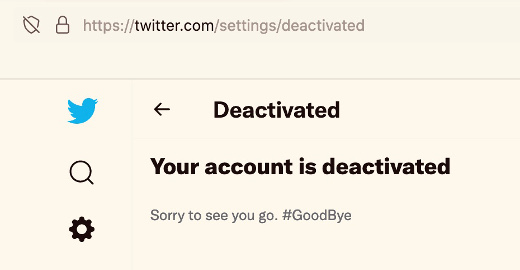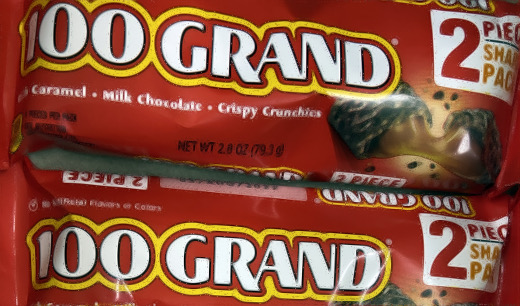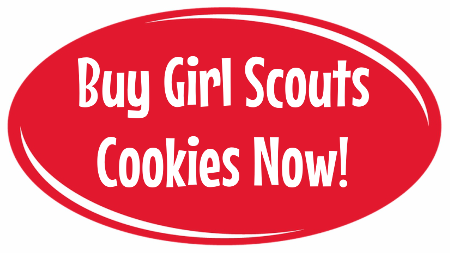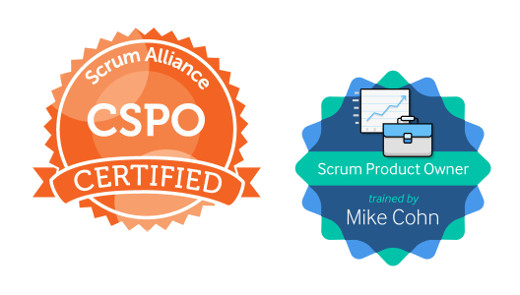It’s Girl Scout Cookie Time
Once again, my daughter is selling Girl Scout cookies. And once again, you my dear reader can have the unique opportunity to support her and the girls in her troop in their learning and developing in scouting, all the while enjoying these tasty cookies!
Whether you go down the traditional path with Thin Mints, Caramel deLites, Shortbreads, Peanut Butter Sandwiches and Peanut Butter Patties, or try the newer varieties including Caramel Chocolate Chip, Lemonades, Toast-Yays and Adventurefuls, you can’t go wrong! Some of these are even gluten free and vegan. All can be shipped directly to the comfort of your own home, wherever you are.
Even if you don’t want cookies but want to support her troop, you can buy “Cookie Shares” where boxes of cookies are donated to worthy causes.
To buy, simply click on the bug red button below:If you don’t see the button or if the link doesn’t work, click here to Buy Girl Scout Cookies Now!
My daughter thanks you in advance for the dozens of boxes of cookies you will be buying! The proceeds of the sales that go to her Girl Scouts troop will help subsidize the activities and badges they are earning throughout the school year as well as Girl Scouts summer camps, which have all pretty much opened back up to normal.
This is from The Hot Iron, a journal on business and technology by Mike Maddaloni.
Did you enjoy this? Subscribe to The Hot Iron by RSS/XML feed or Read by Email
Announcements • Thrive • (0) Comments • PermalinkFifteen Years Of The Hot Iron

I guess if a month goes by without any posts here at The Hot Iron, then that next post should have some significance to it. It just so happens that today, December 30, marks the anniversary of this humble blog going live. And December 30, 2021 marks 15 years since that first Hello World post.
Thank you to all who are reading this now, and to those who have read what I have written here over the years. Where I don’t often hear from readers, stats say people are reading, so I don’t feel like I am talking to myself. I sometimes equate this to my days in college radio when I would do a great show and ask for requests, yet the phone would never ring. However when I would run into people on campus or out on the street, they would tell me they listen, and even mention songs I played so I knew they were sincere. Of course the balance of sharing information and my ego are heavily in play when I write.
What will this 15th year of blogging have in store? We’ll see.
This is from The Hot Iron, a journal on business and technology by Mike Maddaloni.
Did you enjoy this? Subscribe to The Hot Iron by RSS/XML feed or Read by Email
Announcements • Blogging • (2) Comments • PermalinkWhy I Deleted Twitter

This past weekend I did something I have contemplated for a while but couldn’t get myself to do. I deleted my Twitter account.
Some of you may be surprised, especially those who knew how much I promoted Twitter over the years. Others may not be, especially as I haven’t been actively using my account for well over a year and a half. Though I deleted the app from my mobile phone and stopped checking it several times daily back in March of 2020, I was hesitant to drop it altogether.
But I did, and I am great with that decision. Allow me to indulge why I did, but first how I engaged with social media and its positive and negative impacts on my life.
The Good Ol’ Days... in 2007
Social media in the mid-to-late 2000’s was not completely new, as I had a MySpace page and this blog you are reading was also new to me. As I grew followers and made connections with both platforms, I learned about Twitter, and thanks to my friend and fellow improvisor Christopher, I got an account.
But at first, I didn’t get it. What the heck could I say in 120 characters? And who would want to read it? I slowly started following and connecting with people, and using it as a way to promote my blog. Twitter inspired me to build a Web app that is resting in my project graveyard but even then, I wasn’t using it all that much.
For me, it took seeing Twitter in action – literally – to believe in it, and that didn’t happen for another year when I went to Helsinki, Finland as a participant in Nokia OpenLab. There I met people from around the world who were heavy users of Twitter and other social media channel, and I experienced for the first time a group of people tweeting each other as they sat together. Where that latter fact was not what made me the true believer in Twitter that I became, it was continuing the connections with these people who brought me to the platform and kept me there.Behind the short messages were people, and I got to know people not only around the world but around the corner as well. People who were interested in meeting those whom they only saw an avatar of would host Tweetups – in person meetups of Twitter connections. There are several people from tweetups I still keep in touch with today.
Beyond Shiny to a Utility
As I evolved my use with Twitter, the platform evolved as well. Business, traditional media and more individuals were coming on board, and the “invention” of the hashtag made the platform even more useful. It was becoming my primary source for news, as I could follow networks, stations, newspapers and especially the reporters of those outlets. One example of the power of Twitter was one early evening in Chicago when I saw Blackhawk helicopters flying around the Loop. I immediately took to Twitter, and right away people were chiming in on their own sightings and the media was also on the case. It was a Chicago Tribune reporter who then found an obscure mention on the city’s Web site about a Blackhawk training exercise and shared it. Shortly afterwards it made the paper’s Web site.
Twitter became a customer service channel as well, which truly embraced the collaboration that was a hallmark of social media. Starting with Comcast Cares, an account run by a Comcast employee on his own, customer service evolved on the platform, slashing through obnoxious telephone menu trees to get to the people who could make a difference. This extended beyond business, as my former Alderperson in Chicago was an active user – one day on the way to work I tweeted her a picture of a downed tree in my neighborhood, and on the way home it was gone.
The ability to connect and communicate with people you normally couldn’t or wouldn’t be able to connect with was another uniqueness to Twitter. One time I tweeted to Jack Welch, the infamous former CEO of GE. It happened to be at the time the New England Patriots were in the playoffs, and Welch, who was a Boston-area native, replied to me, “Go Pats!” Though not an intellectual conversation to say the least, it was a pleasant surprise. As I was writing book takeaways here at The Hot Iron, I was able to connect with authors and publishers to share my thoughts, as well as the occasional newsmaker and reporter covering them.
What’s Offline is Online Too
Twitter was not in its own world, as it’s obvious it was made up of those from the “meat space.” Over time I saw Twitter conversations becoming more political and divisive. As this was not just impacting Twitter but other social platforms such as Facebook, driving me to quit that platform years ago. Despite this exodus, I still held hope that Twitter could be different and more tolerable to me.
Over the last 5 years though it was really off the rails for me. I would often joke that, though not a financial advisor, I strongly recommended investing in heels, as people were simply digging their heals in and holding their ground and shouting at others. This was far, far from the Twitter I remembered from almost a decade earlier, and one I was not liking. I went as far as deleting all of my old tweets (after backing them up, for some reason) as who knows what I had said in a short message years ago that I didn’t want to come back to haunt me. Over time I was checking the platform less and less.
The Final Straws
As the lockdowns were taking effect in early 2020 and people were at home, angry, scared, or whatever they were feeling, the tweets were reflective of this. It got to be too much, and I deleted the app from my mobile device. Granted I did not shut down the account, but not having Twitter literally at arm’s length for most of my day was actually refreshing. I would check it maybe once a week from a Web browser, then every couple of weeks, then maybe once a month. As Twitter was also a way for friends to connect with me, I was sharing with them over direct messages, or DMs, my decision and my phone number and email if they didn’t already have it. I didn’t make a big deal publicly of my cutback on its usage though.
In between those checks, I really didn’t miss Twitter. I was still on LinkedIn and starting to experiment with Mastodon, an open source, federated (or shared) protocol of connecting individual social media instances together. I was also blogging more, going back to my “roots” of social media – look at my early posts, and I had many commenters, many more than I do today.
Over the weekend I happened to check Twitter and the only mention I had in the month since I last checked it was a tweet from a complete stranger asking me to DM him about a business opportunity. I paused for a moment, and said to myself this was it. It had been almost 18 months since I retreated, and I really didn’t miss it at all. Sure, the ol’ days were good – heck, even great – but today Twitter has lost its luster. Note that in what I have said so far I haven’t mentioned de-platforming, algorithms controlling what you see and don’t see, and the useless testifying of Twitter’s and other social and tech CEOs in front of Congress. Where these certainly played into my thinking (like not believing Twitter is a public square, rather a private space off of it) I had enough reasons to delete my account, and my proof is with the screenshot at the top of this message.
Will I return? I do have access to other Twitter accounts for organizations that I have helped manage, but personally I don’t see it. But never say never, and who knows what else is right around the corner.
Deconstructing Deleting Twitter
Social media was and continues to be a game-changer for how we communicate in the world, for better or for worse. The opposite of social media is not anti-social, rather I see it as returning to the roots of collaboration that the Internet is. My decision to quit Twitter was personal, but not entirely unique, as I have known others who have quit other social media platforms. Where everyone has their own reasons, there is a common thread of the negativity that is gnawing away at the good that social media enabled. It’s this good that I seek, whether on another platform or with a simple hello to someone, online or in-person.
This is from The Hot Iron, a journal on business and technology by Mike Maddaloni.
Did you enjoy this? Subscribe to The Hot Iron by RSS/XML feed or Read by Email
Announcements • Social Media • Strategize • (2) Comments • PermalinkThoughts on Writing 1000 Blog Posts

My last post at The Hot Iron, Lower the Minimum Age to Work, was the one-thousandth post I have written for my blog over the almost 15 years since I started it.
I say that calls for acknowledgment and some reflection.
Where It Began
Over the years I have often mentioned why I started and have continued this blog. In short, I had a client of my Web business who asked me to stop building them a Web site and build them a blog first using specific software. After building theirs, I realized I had no “showcase” blog to use as an example to future clients. I had registered the domain name thehotiron.com years earlier, as I thought a play on “strike while the iron is hot” was a good name for a blog. At the end of 2006, what you are reading this from was born.
I slowly got into writing, namely as I wasn’t much of a writer previously. Some posts were things on my mind, others were on what was bugging me, and others were a way to promote myself and my business. Types of posts emerged over the years, such as mobile phone evaluations, book takeaways and What I Learned for the previous week. No matter what I wrote, I tried to contribute something unique to the global conversation. Looking back on random posts as I am writing this, I think I did a good job at keeping to this mission.
1,000 Could Have Been Sooner, Thanks Social Media
There’s no doubt on the impact on social media in the world. A little closer to home, it certainly impacted what and how often I wrote on my blog. Something that was bugging me could easily be boiled down to 120 characters in a Tweet or a little longer in a Facebook post. Over time however those social accounts have gone away or ground down to a halt, as I have preferred to write in longer form in a platform I control. Am I anti-social? No – I certainly do share links on social media to my blog posts. However it’s nice to have my collection of written thoughts in one place, making The Hot Iron the center of my digital presence – something I have written about before and will continue to in the future. Judging by the little bit of observing I do of hits to the blog, others do find me here and keep coming back.
What’s Next
A grand of posts down, another to go? We’ll see, as I stopped making predictions here a long time ago. A little celebration to go along with this reflection... now that’s something that will happen for certain.
This is from The Hot Iron, a journal on business and technology by Mike Maddaloni.
Did you enjoy this? Subscribe to The Hot Iron by RSS/XML feed or Read by Email
Announcements • Blogging • Thrive • (3) Comments • PermalinkMike Maddaloni Is A Certified Scrum Product Owner
Another timeout for a little self-promotion as I am proud to announce I am now a Certified Scrum Product Owner, or CSPO. A week ago I took a 2-day course and in the process gained certification through Scrum Alliance.
What is a CSPO?
A CSPO is a practitioner of the Scrum. With its origins in software development, Scrum is “framework within which people can address complex adaptive problems, while productively and creatively delivering products of the highest possible value.” A product owner is one of 3 roles on a Scrum team, along with the Scrum Master and Developers. The team delivers software, or whatever the work product is, in an iterative approach over periods of time called sprints, where a sprint can last a few weeks to a month. You can read more on Scrum in the Scrum Guide the “bible” on the framework.The role of the Product Owner is an empowered representative of the stakeholders for the product the entire Scrum team is working on. Its mission is to maximize the value of the product for said stakeholders and its users. High-level responsibilities include defining the Product Goal, managing the Product Backlog (or what the team will be working on), communicating and ensuring transparency.
Why the Product Owner Course? And didn’t you take the Scrum Master course?
Last year I took the course and exam to become a Certified ScrumMaster through Scrum Alliance. Through this process, I was really intrigued by the Product Owner role. In my current job, in many regards I serve as a Product Owner more than I do a Scrum Master. Also, I found a lot more emphasis on the Scrum Master role on the Scrum team “out there” more than I did on the Product Owner. This led me to pursue this course of study and serve in this capacity. Even had I not had this strong interest in being a Product Owner, I feel it important to understand all of the Scrum team roles to better serve as one of them.
The Course Itself
Before the global lockdowns last year, Scrum courses were never taught remotely. You would take a course near you or travel to take one in person. The Scrum Master course I took last year was virtual, though I had signed up for it as an in-person course originally. I was pleased with the last-minute pivot, the instructor and learned a lot from it.
All Scrum trainers have since gone to a virtual model. Where some courses are now starting to be taught in person, the majority are still online. This opened wide the possibilities from where to take the course. As I chose to continue courses through Scrum Alliance, I took the CSPO course through Mike Cohn, a veteran Scrum practitioner, trainer and author.Where I have only taken a few courses online over the years, this was by far the best offering I have experienced. The online “space” is integrated into Agile Mentors, a community and resource center whose membership is included for a year with the course. Before the live sessions, there was about 4 hours of “basics” videos going over the core of the Product Owner role, including quizzes throughout. It was structured this way to ensure to maximize the 2 days of live instruction, and it worked very well. I was equally impressed with the design of the overall experience – Cohn and his Mountain Goat Software spent a considerable amount of time in the branding and technology for this and all of their products.
No exam?
At the lunch break during the first day of the course it dawned on me there was no mention of an exam following the course to earn the certification. During the Q&A at the end of the day I asked this “meta” question. A good discussion followed and Cohn went into great detail on it from his own experience – he was a founder of the Scrum Alliance, and he said for this role it is a challenge to create questions for such an exam, as he has tried himself. Cohn’s upfront and no-nonsense approach was also a selling point for me on training with him. The non-binding quizzes throughout the pre-course videos did help in reinforcing the materials.
Without an exam and by actively participating in the course, this is the only qualification for the CSPO certification. Where I felt it was a little anticlimactic, I have decided it will be up to me to challenge myself as a Product Owner and always quiz myself. But what a better challenge for Scrum Alliance to develop an exam for this certification!
Next Steps and Kudos
I am looking forward to my continued journey with Scrum, the better way to do things – just ask Elon Musk! I have been asked my employer to help emphasize and further the Product Owner role, and I am up to the task. I also welcome your questions on Scrum in general. If you are thinking of studying for it as I did, I highly recommend the course from Mike Cohn. Thanks to him, Stacey Ackerman of the Agile Mentors community and the numerous classmates I had from around the area and the world who made the CSPO course a memorable experience.
This is from The Hot Iron, a journal on business and technology by Mike Maddaloni.
Did you enjoy this? Subscribe to The Hot Iron by RSS/XML feed or Read by Email
Announcements • Business • Agile / Scrum • Thrive • (0) Comments • Permalink



